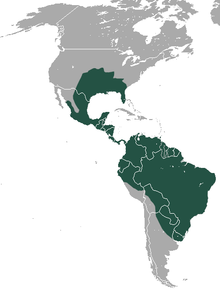Nine-banded armadillo
The nine-banded armadillo (Dasypus novemcinctus), or the nine-banded, long-nosed armadillo, is a species of armadillo. The nine-banded armadillo is an insectivorous animal. Ants, termites, and other small invertebrates make up most of its diet. The armadillo can jump 3–4 feet (91–122 cm) in the air when scared.[2]
| Nine-banded armadillo | |
|---|---|

| |
| Scientific classification | |
| Kingdom: | |
| Phylum: | |
| Class: | |
| Order: | |
| Family: | |
| Subfamily: | |
| Genus: | |
| Species: | D. novemcinctus
|
| Binomial name | |
| Dasypus novemcinctus | |

| |
| Nine-banded armadillo range | |
Range
changeThe nine-banded armadillo is spreading more far out in both the north and east of the United States. It crossed the Rio Grande from Mexico in the late 19th century. At the same time, it was introduced in Florida by humans. By 1995, the species was found in Texas, Oklahoma, Louisiana, Arkansas, Mississippi, Alabama, and Florida, and recently seen as far north as southern Nebraska, Illinois, and Indiana.[3] The main reason of this fast expansion is because the species have few or no natural predators in the United States. It is also because Americans do not hunt or eat the armadillo. In late 2009, the state of North Carolina considered a hunting season for armadillo to slow them down.[4][5] Outside the United States, the nine-banded armadillo is in Central and South America and northern Argentina and Uruguay.
Diet
changeNine-banded armadillos are mostly insectivores. They find their meals by pushing their snouts into soil and digging. They dig up grubs, beetles, ants, termites, and worms. They sometimes also eat amphibians, small reptiles, fungi, and carrion.
Behavior
changeNine-banded armadillos do not live in groups. They are nocturnal,[6] which means that they are lively at night instead of the day. Through soil excavation, the nine-banded armadillo's ability to burrow underground helps the armadillo protect itself from predators and protect their young. They are purposely positioned in a way, such as on a slope, where they have vegetation around, protective layers around, and easy access to nearby burrows. The burrows they make are about 8 inches (20 cm) wide, 7 feet (2.1 m) deep, and 25 feet (7.6 m) long.[7] Armadillos usually mark their territory.[7] The armadillo can jump 3–4 feet (91–122 cm) in the air when scared.[2] This may be dangerous on roads, because it could get hit by a car.[8] Their top protection mechanism is their rigid, bony, armored shell.
Reproduction
changeMating is usually done from July to August in the Northern Hemisphere and November to January in the Southern Hemisphere. A single egg is fertilized. Then it splits into four identical embryos, each which makes its own placenta. The nine-banded armadillo gives birth to genetically identical quadruplets.[9][10][11][12]
After birth, the quadruplets remain in the burrow, drinking the mother's milk for about three months.[7] Then they begin to hunt for their meals with the mother. After six months to a year, they leave.[13]
A single female can produce up to 56 young over the course of her life.[14]
References
change- ↑ IUCN SSC Edentate Specialist Group (2008). "Dasypus novemcinctus". IUCN Red List of Threatened Species. Version 2008. International Union for Conservation of Nature. Retrieved 30 December 2008.
- ↑ 2.0 2.1 "How high can a nine-banded armadillo jump?". Everyday Mysteries. Library of Congress.
- ↑ Armadillo expansion, Armadillo Online, archived from the original on 28 November 2006, retrieved 7 June 2010
- ↑ Steve Windham (Chairman), Public Hearings applying to 2010-2011 Fishing, Hunting and Trapping Seasons (PDF), North Carolina Wildlife Resources Commission, retrieved 7 June 2010
- ↑ Jefferson Weaver (9 December 2009). "New regulations feature armored possums". The News Reporter. Retrieved 8 June 2010.[permanent dead link]
- ↑ "Armadillo Observation". Retrieved 2012-06-11.
- ↑ 7.0 7.1 7.2 "Texas State Animal - Nine-banded Armadillo". Archived from the original on 2014-06-27. Retrieved 2012-06-11.
- ↑ "Nine-Banded Armadillo - Dasypus novemcinctus - NatureWorks". Retrieved 2012-06-11.
- ↑ "polyembryony (biology) -- Britannica Online Encyclopedia". Retrieved 2012-06-11.
- ↑ "The Nine-banded Armadillo (Dasypus novemcinctus)". Edis.ifas.ufl.edu. Retrieved 2009-12-17.
- ↑ Loughry, W.J; Prodohl, Paulo A; McDonough, Colleen M; & Avise, John C (May–June 1998), "Polyembryony in Armadillos" (PDF), American Scientist, 86 (3): 274–279, Bibcode:1998AmSci..86..274L, doi:10.1511/1998.3.274, S2CID 196608283, archived from the original (PDF) on 2012-02-13, retrieved 2012-06-11
{{citation}}: CS1 maint: multiple names: authors list (link) - ↑ Hamlett, G.W.D (September 1933), "Polyembryony in the Armadillo: genetic or physiological?", The Quarterly Review of Biology, 8 (3): 348–358, doi:10.1086/394444, JSTOR 2808431, S2CID 86435985
- ↑ Feldhamer, George A.; et al. (2007), Mammalogy: adaptation, diversity, ecology, Baltimore, Maryland: Johns Hopkins University Press, ISBN 978-0-8018-8695-9, retrieved 7 June 2010
- ↑ "Nine Banded Armadillo - facts, diet, habitat, reproduction, life span, predators and pictures". July 2011. Retrieved 2012-06-11.
- Louise H. Emmons and Francois Feer, 1997 - Neotropical rainforest mammals: a field guide.
- eNature entry Archived 2009-03-03 at the Wayback Machine
- Nixon, Joshua. Armadillo Expansion Archived 2006-11-28 at the Wayback Machine, September 14, 2006, retrieved December 3, 2006.
- Trapping the nine-banded armadillo Archived 2011-04-23 at the Wayback Machine
